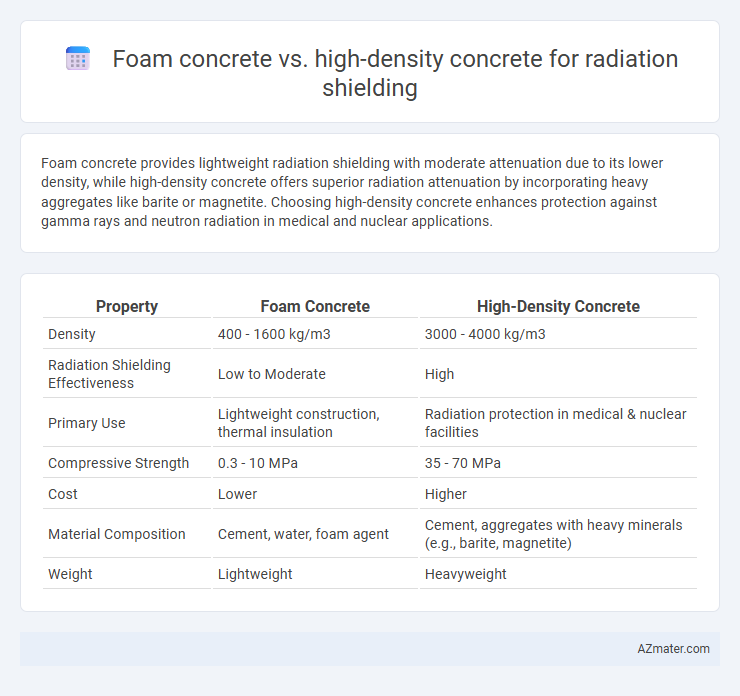Foam concrete provides lightweight radiation shielding with moderate attenuation due to its lower density, while high-density concrete offers superior radiation attenuation by incorporating heavy aggregates like barite or magnetite. Choosing high-density concrete enhances protection against gamma rays and neutron radiation in medical and nuclear applications.
Table of Comparison
| Property | Foam Concrete | High-Density Concrete |
|---|---|---|
| Density | 400 - 1600 kg/m3 | 3000 - 4000 kg/m3 |
| Radiation Shielding Effectiveness | Low to Moderate | High |
| Primary Use | Lightweight construction, thermal insulation | Radiation protection in medical & nuclear facilities |
| Compressive Strength | 0.3 - 10 MPa | 35 - 70 MPa |
| Cost | Lower | Higher |
| Material Composition | Cement, water, foam agent | Cement, aggregates with heavy minerals (e.g., barite, magnetite) |
| Weight | Lightweight | Heavyweight |
Introduction to Radiation Shielding Materials
Radiation shielding materials require high-density properties to effectively block or attenuate ionizing radiation, with high-density concrete often favored for its superior ability to absorb gamma rays and neutrons due to its compact aggregate composition. Foam concrete, characterized by its low density and cellular structure, provides limited radiation protection and is primarily used for thermal insulation rather than shielding. Choice of material depends on the specific radiation type and energy level, where high-density concrete offers enhanced shielding performance essential for medical, nuclear, and industrial applications.
Overview of Foam Concrete
Foam concrete is a lightweight, porous material created by incorporating air bubbles into the cement mix, resulting in lower density compared to traditional concretes. This type of concrete provides moderate radiation shielding capabilities due to its cellular structure, which reduces weight while offering insulation properties. Its versatility and ease of application make foam concrete suitable for non-critical shielding areas where weight reduction is a priority.
Overview of High-Density Concrete
High-density concrete is engineered with aggregates such as barite, magnetite, or hematite to significantly increase its density, typically ranging from 3,200 to 4,800 kg/m3, which enhances its effectiveness in radiation shielding applications. Its high atomic number components provide superior attenuation of gamma rays and X-rays, making it essential in medical, nuclear, and industrial shielding environments. Compared to foam concrete, high-density concrete offers greater protection against ionizing radiation due to its compact microstructure and increased mass per unit volume.
Key Physical Properties Comparison
Foam concrete offers a lower density range of 400-1600 kg/m3, providing excellent thermal insulation but limited radiation shielding due to its high porosity and lower atomic number materials. High-density concrete, with densities between 3200-4500 kg/m3 achieved by adding heavyweight aggregates like barite or magnetite, provides superior gamma radiation attenuation and neutron shielding. The higher compressive strength and reduced porosity of high-density concrete make it ideal for environments requiring robust radiation protection and structural integrity.
Radiation Attenuation Capabilities
High-density concrete exhibits superior radiation attenuation capabilities compared to foam concrete due to its increased mass density and elemental composition, which effectively absorb gamma rays and neutrons. Foam concrete's lower density results in reduced shielding efficiency, making it less suitable for environments requiring stringent radiation protection. In radiation shielding applications, selecting high-density concrete can significantly enhance protection by minimizing radiation penetration and safeguarding personnel and equipment.
Structural Strength and Durability
High-density concrete exhibits superior structural strength and enhanced durability compared to foam concrete, making it highly effective for radiation shielding applications in nuclear facilities and medical environments. Foam concrete, characterized by its lower density and increased porosity, provides limited load-bearing capacity and reduced long-term resilience under radiation and environmental stress. The dense matrix of high-density concrete improves radiation attenuation while maintaining mechanical integrity, ensuring prolonged protection and structural stability in radiation shielding installations.
Thermal and Acoustic Insulation Performance
Foam concrete offers superior thermal insulation due to its low density and high porosity, effectively reducing heat transfer in radiation shielding applications. High-density concrete, while excellent for radiation attenuation, provides limited thermal insulation but excels in acoustic performance by absorbing low-frequency sound waves. Choosing between foam and high-density concrete depends on balancing insulation needs with radiation shielding effectiveness.
Installation and Handling Considerations
Foam concrete offers lightweight properties that simplify transportation and reduce labor costs during installation, making it easier to handle on-site compared to high-density concrete, which requires specialized equipment due to its heavy weight and increased density. High-density concrete provides superior radiation attenuation but demands careful handling to avoid structural stress and prolonged curing times, impacting project timelines. Both materials necessitate tailored placement techniques, with foam concrete allowing faster application and high-density concrete requiring precision to maintain its shielding integrity.
Cost Implications and Economic Feasibility
Foam concrete offers lower material and transportation costs due to its lightweight nature, making it economically feasible for large-scale radiation shielding projects where budget constraints are critical. High-density concrete, with superior radiation attenuation properties, demands higher initial investment due to expensive aggregates like barite or magnetite, but can reduce long-term costs by enabling thinner shielding structures and lower maintenance. A thorough cost-benefit analysis considering project scale, radiation levels, and structural requirements is essential for selecting the appropriate concrete type with optimal economic outcomes.
Best Applications and Recommendations
Foam concrete, with its lightweight and excellent thermal insulation properties, is best suited for low to medium radiation shielding applications where structural load and weight savings are critical, such as in non-critical containment barriers and portable radiation shields. High-density concrete, enriched with heavy aggregates like barite or magnetite, provides superior radiation attenuation, making it ideal for medical facilities, nuclear power plants, and radiology rooms where maximum protection against gamma rays and X-rays is essential. For optimal results, high-density concrete is recommended when shielding requirements exceed 0.5 MeV photon energies, while foam concrete is preferred for reducing structural loads without compromising moderate shielding effectiveness.

Infographic: Foam concrete vs High-density concrete for Radiation shielding
 azmater.com
azmater.com